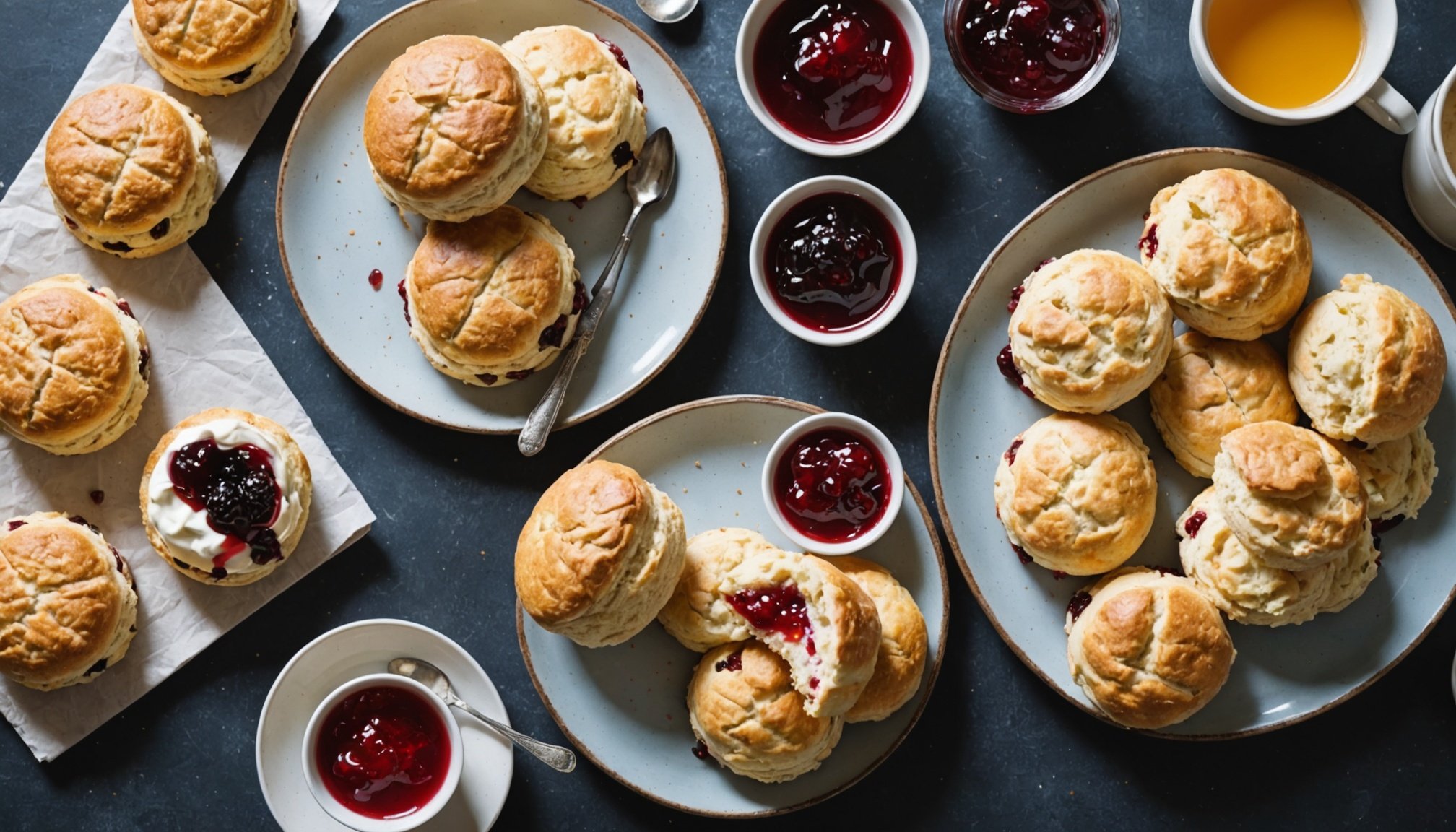Understanding English Scones
The history of English scones is a fascinating journey through culinary evolution, beginning in Scotland around the early 1500s. Originally, scones were a type of unleavened, round, and flatbread, traditionally made from oats and griddle-baked. Over time, they have transformed significantly, particularly in how they are prepared and the ingredients used. Today, the recipe for English scones includes wheat flour and is often baked rather than griddle-cooked.
The cultural significance of scones is notably tied to British tea time traditions. They became a staple in the 19th century, largely popularised by Anna, the Duchess of Bedford, who introduced afternoon tea to stave off hunger between lunch and dinner. This made scones synonymous with British tea time—a ritual that reflects both culinary heritage and social customs.
Also read : The Crucial Role of Healthy Eating: Why It Matters for Your Well-being
Throughout the UK, scones have adapted to regional tastes and ingredients. For instance, in Devonshire, the emphasis is on clotted cream, while in Cornwall, the order of cream and jam is taken with utmost seriousness. Scones may have humble beginnings, but they remain a quintessential part of British culture, embodying both simplicity and sophistication.
Clotted Cream: The Perfect Accompaniment
Nestled in the heart of British tea traditions, clotted cream is the creamy crown jewel that accompanies English scones. Its unique, velvety texture offers a rich contrast to the light, fluffy dough of a freshly baked scone. Often confused with butter or whipped cream, clotted cream is in a class of its own due to its distinctively thick consistency and subtle sweetness.
In the same genre : Sure! How about this: Master the Kitchen: Expert Tips and Proven Techniques for Culinary Success;150Mouthwatering Recipes You Must Try Today: A Culinary Journey Awaits
Curious about how to make clotted cream at home? The process may require patience, but mastering clotted cream creation is truly rewarding. Start with high-quality, full-fat cream, spread it in a shallow dish, and gently heat it in an oven to allow the cream to ‘clot’ around the edges. After cooling, a golden crust forms on top, ready to be scooped out and spread over your scone.
Pixie-dusted with tradition, clotted cream elevates English scones to a sublime level of indulgence. It pairs perfectly with the jam of your choice, lending a creamy balance to sweet and tart flavors alike. Whether you’re indulging in a classic raspberry jam or experimenting with a spicier option, clotted cream is undeniably the ultimate scone companion.
Recipe for Perfectly Fluffy English Scones
Baking fluffy English scones at home is an art that combines precision and love. To start, gather these essential ingredients: 225g of self-raising flour, 55g of butter, 25g of sugar, a pinch of salt, and 150ml of milk.
Begin by preheating your oven to 220°C (200°C for fan ovens) and lightly grease a baking tray. Sift the flour and salt into a bowl, then rub in the butter until the mixture resembles breadcrumbs. Stir in the sugar, creating a well in the center for the milk. Gently mix to form a soft dough.
For expert baking tips, avoid heavy kneading; instead, handle the dough lightly to preserve its airiness. Roll out the dough on a floured surface to a 2 cm thickness. Using a round cutter, stamp out scones, ensuring smooth edges for an even rise.
Transfer to the tray, brush with milk for a golden finish, and bake for 12-15 minutes until well-risen and golden. These scone recipe steps ensure scones with the ideal texture and rise. Enjoy right out of the oven or cooled with your favorite toppings.
Exploring Jam Pairings for Scones
The versatility of jam pairings can significantly enhance your English scones experience. Traditional options include strawberry and raspberry jams, which offer a sweet and slightly tart contrast to the rich clotted cream and buttery scones. Their vibrant flavors and colors are a timeless choice, perfectly complementing the classic British tea time ritual.
Venturing beyond the classics, consider experimenting with unique flavor combinations. Try blackberry with a hint of lavender for earthy overtones, or apricot with ginger for a spicy kick. These inventive pairings can refresh your palate by providing an intriguing twist to your scone experience.
Creative Jam Ideas
- Lemon curd: Offers a zesty, refreshing alternative, ideal for summer gatherings.
- Fig and walnut spread: Rich and textured, adds depth and a hint of luxury.
- Rhubarb and rose: A floral, tart option that pairs beautifully with the sweetness of the scone.
Selecting the right types of jam is crucial for creating a memorable tea time. The key is to balance sweet and tangy flavors, ensuring they meld harmoniously with both the scone and the accompanying cream.
Visuals and Presentation
The art of scone presentation transforms a simple baked good into an elegant masterpiece. Mastering scone presentation starts with considering the visual appeal. Begin by selecting a tiered platter to add height, creating a focal point on your tea table. This not only showcases the fluffy English scones but also adds sophistication to the setup.
Adorning your platter with seasonal berries or edible flowers can enhance the aesthetics. These elements introduce pops of colour and relate to the traditional freshness synonymous with British tea time. Remember, the contrast between the creamy clotted cream, vibrant jams, and the golden-brown scones amplifies visual allure.
Moreover, essential serving tools—like cake knives, dessert forks, and fine china—elevate the experience by offering both functionality and elegance. Using a lace tablecloth or vintage napkins can further enrich the ambience, enveloping guests in a quintessentially British atmosphere.
Food styling, much like baking, is an art that enhances the overall experience. Striking a balance between warmth and sophistication through thoughtful presentation can make your tea setup memorable and distinctly charming. Thus, aesthetics play a crucial role, bridging culinary delight with visual satisfaction.
Troubleshooting Common Scone Issues
Baking English scones can occasionally present challenges, but understanding common baking problems can lead to perfect results. Let’s address some frequent scone troubleshooting concerns and how to resolve them efficiently.
Identifying and Solving Scone Issues
-
Dense Scones: Often caused by overmixing the dough, dense scones can be avoided by mixing just until ingredients are combined. Use light hands to preserve pockets of air, ensuring the dough remains fluffy.
-
Dry Scones: This issue typically stems from excessive baking. Keep a close eye on the oven and remove scones once they are golden brown. Additionally, measuring ingredients accurately, particularly the flour, can prevent dryness.
-
Flat Scones: Insufficient rising is a common complaint. Ensure the baking powder is fresh and properly measured. The dough should be a consistent 2 cm thickness for an ideal rise.
Ingredient Freshness and Temperature
Ingredient freshness critically impacts the outcome. Always use fresh baking powder and chilled butter. Room temperature liquids also contribute to better dough consistency. Emphasising these points ensures your scone recipe results in delightful, perfectly risen treats with optimal texture and flavour. Understanding these aspects fosters a smoother baking experience.

